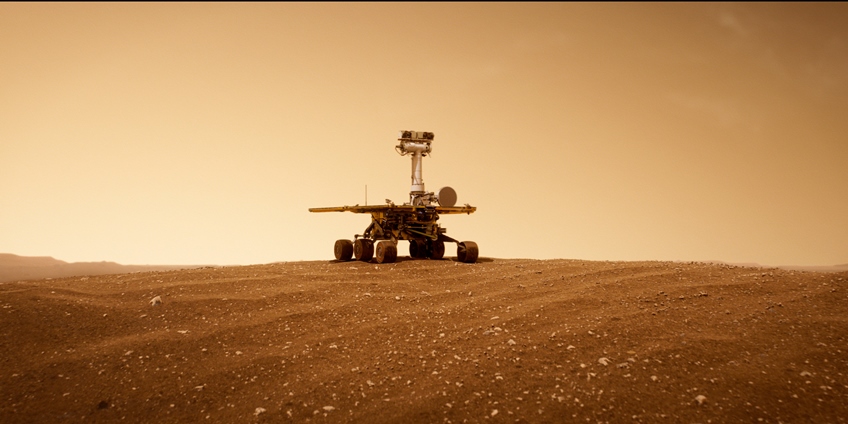Joyce Glasser reviews Good Night Oppy (November 4, 2022) Cert TBC, 105 mins.
For its first expository twenty minutes, when the scientists and engineers are introduced and the twin rovers that will be launched into space are built, tested and launched, Good Night Oppy resembles a standard space documentary, similar to the Apollo-related documentaries, but targeting Mars instead of the moon. And then a somewhat clinical film turns into a heart-warming, heart-breaking and thought provoking story of longevity, working into old age and the nature of discovery itself. The data the two robots send back to earth become secondary to what NASA’s Mars Exploration Rover Mission (MER) learn about the relationship between people and machines.
Planetary geologist Steve Squyres’ dream was to send a geologist robot to Mars to search for evidence of water, for wherever there was water, there was life. After ten years of writing proposals, at last he and a team at NASA’s Jet Propulsion Laboratory get the go ahead.
In January 2004, twin sister robots Spirit and Opportunity (the names came from a public competition) successfully land on different parts of Mars and begin work. The staff compare the 2003 launch of Spirit (June 10, 2003) and Opportunity (July 7, 2003) to giving birth and sending children out into the world without having prepared them for all of life’s obstacles.
A diverse (in gender, race and to some extent, age) group of scientists, managers and engineers had to adapt to a strict timetable, waking the robots up with music, issuing commands and awaiting the results hours later, as communication that far into space is dependent on many factors such as energy use. Because Mars is rotating on its own axis it often turns its back to Earth, taking the rovers with it. The rovers go dark, just like night-time on Earth. The communication managers also have to adjust to Mars time, with meeting times shifting and some meetings starting at midnight. The enthusiastic staff do not mind the anti-social hours: The robots are only expected to last for 90 days.
And here is where Ryan White’s documentary becomes a thing of wonder. Spirit, who has the toughest brief and conditions, landing on the Gusev Crater, where scientists thought they spotted evidence of past rivers, dies first, in 2011. Oppy, as Opportunity was affectionately called, lands on the other side of Mars in the flat Meridiani Planum region where scientists had spotted a mineral called grey hematite that is often found in the presence of water.
Over time she was redeployed, travelling far more and longer than she was built for. Oppy was diligently analysing the minerals in the far-away Endeavour crater in her 15th year.
We are introduced to the team who labour for years on this project and watch them wait in tense silence for the launch, and then the landing. When the sisters land, within three weeks of one another, the team is cautiously optimistic. When the robots become operational and respond, the team is ecstatic.
That is not to say that all fears are dissipated, but the fears are not coming from Earth. Being on Mars is a learning curve for humans and machines alike. One spooked robot alerts the team that there is a foreign obstacle in its way. The team look into the matter and relay information back that it’s just the machine’s shadow.
Soon both rovers get the hang of it, and Spirit sends the first colour photographs of the planet back to Earth. Shortly after, Oppy does the same.
During their time on Mars the rovers face the foreseeable obstacles of sandstorms, broken and stuck wheels, and shutdowns necessitated by Mars’ extremely cold and long winters. The reawakening is also a stressful time for the NASA team. When we hear the wake up music, Here Comes the Sun, we, too, breathe a sigh of relief.
But not all weather effects are foreseeable. Early on a Martian whirlwind, or “dust devil” zooms over the Columbia Hills and strikes Spirit like a plague. The scientists on Earth fear for the worse. The threat and concerns gradually turn to elation after that dust blast turns out to have cleaned Spirit’s solar arrays, like a car wash, without zapping its precious energy. This is a significant moment, as the team realise that these dust flybys give the rovers a new lease of life.
As the years pass some of the original team move on or retire. At least one new recruit was an eighth grade science student from a small farming town at the time of the launch. She was inspired to apply to NASA and now manages communications with Opportunity.
Not all the obstacles the rovers were originally designed to encounter are foreseeable. As time passes, the team has to make adjustments for Oppy who is working through her old age. Reasonable adjustments are made for arthritis in the shoulder joints by decommissioning Oppy’s arm to save it from breaking. Arthritis has set into her front wheel, too.
Dust accumulation between the cables is the equivalent of grey hair – but it is not just cosmetic. And then there’s memory loss. To avoid Oppy forgetting the information collected while she slept, “No nap today” messages were sent. Oppy would dutifully send the data before going to sleep. One scientist was dealing with a relative with Alzheimer’s at the time and found the experience with Oppy helped her with her relative and vice-versa.
Oppy keeps going, determined to find signs of life – which she does, identifying a layer of clay minerals, a sign of drinkable (as opposed to acidic) water. By now Oppy has become a kind of celebrity, receiving letters from the public and is discussed on talk shows.
With her days numbered, the engineers want to see what Oppy looks like – like a parent would cherish photos of their offspring working abroad for long periods. They are granted permission to use precious energy to see the creation they had not seen in fifteen years. Oppy takes a selfie.




